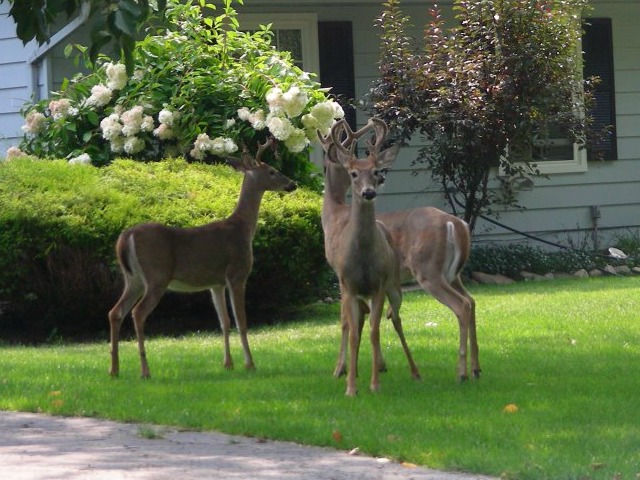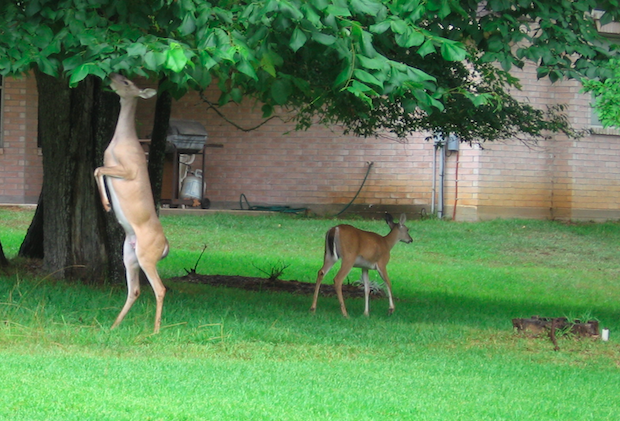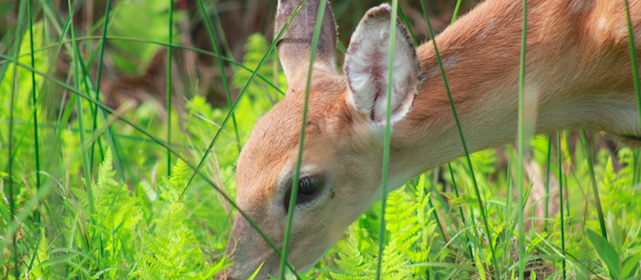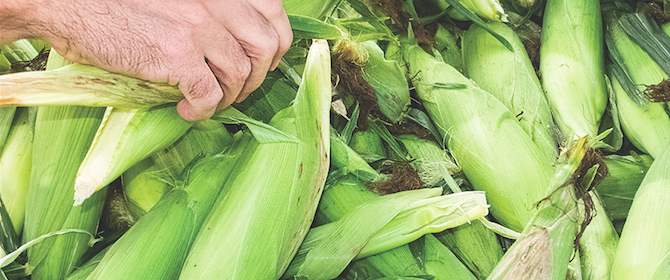This Land is Your Land, This Land is My Land ● by Colleen Wells
The greatness of a nation and its moral progress can be judged by the way its animals are treated.
— Mahatma Gandhi
A doe stands by the edge of a neighborhood street in a wooded area east of Clarizz off 3rd street. She casts her gaze at my car as I slowly drive by. Then behind her two fawns rush to her side. One of them is gnawing on leafy green vegetation which hangs from its mouth. This is a common scene around Bloomington, where I’ve even witnessed a doe nurse her fawns in the middle of Maxwell Lane.
While deer are a species native to Indiana, there was a period of time from 1893-1934 when deer were absent from the landscape due to hunting and habitat loss. Introduced back into the environment in the mid-1930s, the population is growing despite further loss of habitat and hunting. To help keep the balance in check, controlled hunts have been held in some Indiana state parks as early as 1993.
Deer seem to contain an ancient wisdom reflected in their eyes and can adapt to an ever-changing environment. Some think they have adapted too well and that they are wreaking havoc on the ecosystem. Others feel strongly that there must be a non-violent solution for human-deer coexistence.

●
And yet the debate points to issues even greater than the deer. It calls for a closer look at what is happening with the environment as a whole. And in a town progressive in its environmental stewardship, many are wondering about the decisions that have been made.
In September 2010, the DTF (Deer Task Force), comprised of eleven members with diverse expertise, began meeting monthly. It was appointed by city officials to explore options and make recommendations to local officials and Indiana Department of Natural Resources (IDNR). The Executive Summary of their final report describes concerns for residential neighborhoods as well as the approximately 1,200 acre Griffy Lake Nature Preserve: “When it comes to deer at Griffy Woods, clear evidence points to ecosystem damage by deer – native tree seedlings are not regenerating; herbaceous plant species are severely compromised and possibly going locally extinct; invasive species are taking over some areas; the forest understory is unnaturally open; and the understory-reliant birds and other animals are losing habitat.”
The Summary also addresses our role in the problem: “The increased presence of deer in the woods and in residential areas is the direct result of human action. We have fragmented wildlife habitat, sprawled ourselves across the landscape, provided deer with ideal ‘edge’ environment and eliminated virtually all deer predators. As a result, deer are abundant. In some areas, and to some residents, deer are overabundant. Deer are not to blame for this situation—we are.”
Task Force recommendations call for a deer cull at Griffy Lake Nature Preserve using hired sharpshooters and additional lethal methods of handling the in-town deer including a “trap and kill management” during which deer are lured into a cage with bait to reduce stress then shot. The cull at Griffy Lake may begin as early as November 15, 2014.
Bob Foyut, a wildlife rehabilitator and a member of the Deer Task Force, stressed the complexity of the matter. He says that while “for the public it’s a very emotional issue,” the task force worked well together to develop solutions. The decision to kill the animals is not something Bloomington officials or residents take lightly.
Lethal methods for eliminating deer are considered and employed in many areas of the United States. For example, in a report in Newsday, Stephanie Boyles Griffin, the senior director of innovative wildlife management program for the Humane Society of the United States, who discussed the Bloomington issue with former Deputy Mayor, Maria Heslin, wrote that in Hastings-on-Hudson, “gardening enthusiasts arrived at a village meeting to hire someone to cull a local herd of deer.” In this case, when backlash from residents ensued, non-lethal options were instilled. PZP (Porcine Zona Pellucida), a contraceptive vaccine delivered through a dart, was proven effective in closed areas including Fripp Island, S.C. Hastings-on-Hudson is the first open community to try this.
The article also states, “A second non-lethal technique ready for widespread adoption is being tried in suburban Baltimore and Washington, D. C. and in communities in California. Does are being sterilized, their ovaries removed in a 30-minute procedure perfected by veterinarian Steve Timm of Wisconsin, working with wildlife biologist Anthony DeNicola of Connecticut, a sharpshooter who owns a business that until recently specialized in culling deer.” DeNicola is the founder/president of White Buffalo Inc., the company who will conduct Bloomington’s cull.
Heslin said of Boyles Griffin, “In 2012, I was hearing rumblings that lethal options might be on the table, so I tried to find a national expert who could help the DTF fully explore non-lethal means. Through a connection I made with the president of the group Farm Sanctuary, I had the opportunity to meet HSUS wildlife expert Stephanie Boyles Griffin. She and I had several conversations about how other communities handled the challenges of deer management, and she talked a lot about how the issue, if not handled incredibly thoughtfully, can tear communities apart. She offered to come to town to give a public presentation or speak with Council and do a site assessment, but she needed to be invited by the decision-making body — in this case, City Council. … Just a couple of days after that phone call, the DTF issued its final report.”
Non-lethal methods were explored by the Deer Task Force including “Fencing,” “Deterrents and Repellants,” “Reintroduction of Predators,” “Trap and Translocate,” “Contraception,” and “Sterilization.” Details in a Taskforce powerpoint, available online, relating impracticalities of non-lethal methods are included and clearly expressed. For example, one of the concerns about contraception is that it “addresses population growth over time, but not immediate concerns with human-deer conflicts.”
Costs of both lethal and non-lethal methods are also listed. Sterilization costs “$800-$1,000/doe plus ongoing maintenance.” Costs for Trap and Euthanize are “$300/deer plus ongoing maintenance” and Sharpshooting ranges from $200-$350 per deer plus continued maintenance.
Rebecca Warren, Executive Director of the Monroe County Humane Society, addressed the challenge of the human-wildlife balance. “Bloomington is rich with parks and preserves, laying the ground work for an abundance of wildlife taking up home here. There has to be a healthy balance of accepting that we choose to live in an area that’s also attractive to animals and wildlife. I can accept that animals might eat my Hosta plants and moles are going to leave holes in my yard, but I also don’t want to see wildlife beginning to pose safety risks to themselves or the community.”

●
She also explained how educational efforts about animals are beneficial to wildlife such as deer. “Humane Education is absolutely one of the largest pillars in our organization. Teaching both youth and adults how to live humanely with animals, both at home and in the wild, animal safety and teaching kindness are core to Monroe County continuing to be a safe place for animals, wild and domestic. I think there’s always room for our programs to learn and grow as a community’s needs grow.”
Use of non-lethal methods is still the hope of some residents of Bloomington including members of BANIDS (Bloomington Advocates for Nonviolent Innovative Deer Stewardship). The organization recently called for legislation to ban bow-hunting which is legal in city limits. BANIDS is pushing for a waiting period of two years before lethal methods are taken. During this time an accurate census of the deer at Griffy Lake could be taken and innovative solutions explored.
Heslin cites this as one of the reasons the debate is so polarizing, “National experts and common sense dictate that you need to count deer before any type of management plan is put in place so you know the scope of the issue, yet the City refuses to do so having too few deer actually causes ecological harm so not knowing the baseline yet killing up to 100 is irresponsible.”
A Strange Stew
A quest into understanding more about Bloomington’s deer community begins at the farmer’s market. Amongst the autumnal offerings is a table helmed by Alyce Miller displaying information about the impending deer cull at Griffy Lake. Indiana University Miller is Professor of English and Creative Writing at IU; she is a passionate advocate and writer who has practiced law in the area of animal welfare.
“At first I was actually incredulous,” Miller says. “I sort of thought it was a bunch of… to be honest a kind of wacky minority of people who had never dealt with animals. I wasn’t very charitable in my thoughts, but I didn’t think it was going to become what it became… it never occurred to me that [the Task Force] would recommend a lethal method.”
She adds, “I had no idea of how powerful they were in terms of grabbing the attention of their council members.”
Having studied the situation for several years while being active in council meetings, Miller, who also teaches an animals and ethics course and wishes she had a penny for every time she’s been called a Bambi lover, attributes misinformation and fear of wildlife as part of the issue.
She moved here from San Francisco, the first city in the U.S. to mandate composting. When asked if environmental initiatives related to the environment occur there that perhaps we should model, she says, “The deer issue is tied into environmental issues for me. We need to stop using herbicides. The city uses herbicides, and people are constantly spraying Round-up in their yards here. I’ve never lived in a place that’s so suburban. The deer issue is tied into environmental issues for me. In Berkley they’ve outlawed all gas-powered trimmers, edgers, blowers, and mowers, and they’ve outlawed using herbicides … so it is possible.”
Miller points to the irony that “lawns attract deer because they are edged species like we are and they like open savannahs like we do and though people don’t realize … they have provided inadvertently the perfect habitat or attractant for deer.”
Miller explains how a misconception over who “owns” wildlife originated.
“The public trust doctrine came out of Roman law through British Common Law and is a concept in the U. S. We the people own all the resources. We own the waterways. Basically wildlife belonged to no one and everyone. People think the DNR own the deer. No they don’t.”
What Happens When You Remove Jenga Blocks from the Tower of Biodiversity
Jim Poyser, Executive Director of Earth Charter Indiana, which, in his words, is “a state-wide non-profit organization that works on issues of political transparency, waged equality, social and peace justice issues, and all that within the ecological footprint of our earth.”
“It’s a complicated issue,” Poyser says. My perspective on it is the World Wildlife Fund issued a report yesterday that is devastating when it comes to the state of animals globally. The numbers are more shocking than we’ve ever seen before, and I think they even surprised the World Wildlife Fund people.”
Poyser continues, “One of the conclusions of the statistics is that while animals have diminished world-wide at an alarming rate, human population over the last 40 years on the planet has gone from around 4 to over 7 billion. We are a species run amok. If part of the perspective of this deer imbroglio in Bloomington is that the deer are running amok, I would say there’s an interesting analogy for you. People are running amok and … when it comes to a more macro issue where you’ve got habitat for animals, you have humans through development encroaching on it. Then obviously the most important thing is once you have removed the predator, a keystone species from an ecosystem, you’re going to have proliferation. Deer are extremely destructive to a forest system. You can’t blame them, they’re just animals. And they’re animals reproducing, just like we’re animals reproducing. You can’t blame us. It’s the fundamental right to reproduce, but the Tragedy of the Commons here is that every single deer is God’s creature depending on how you interpret God.”
He adds, “If you remove these Jenga blocks from the tower of the ecosystem, you need biodiversity and anything that encourages biodiversity should be embraced. We need more green spaces. We need corridors and easements, and that’s the key with the predator.”
On the Other Side of the Fence
Keith Clay is a Distinguished Professor of Biology at IU. His specialty is community ecology, which he describes as “how organisms interact in ecological communities.” Clay was also a member of the Deer Task Force. He has been the Director of the IU Research and Teaching Preserve since the day it was established in 2001, and he has tried to engage in research projects that take advantage of the natural areas of the preserve that are also addressing locally relevant issues. “I’ve been doing research as part of my position in the Griffy Lake area for 25 years at least or more. And a lot of it is focused on plants, their growth, reproduction, establishment, but also how they’re interacting with diseases, herbivores, animals that are eating plants. I’ve been aware that there’s been a gradual attrition of plant diversity at Griffy for quite a while. For example, a PHD student in the late 90s, worked on a group of plants that you can hardly find any more. In the late 90s, they were common. Now they’re not common. You can hardly find them pretty much. And at the same time we’re seeing these ever-increasing populations of deer.”
Clay explains, “Whether deer were causing these losses of plants we established I think it was like in 2005, a couple of exclosures, where we just built fences to keep deer and other large animals out to see what would happen and quite quickly stuff started growing, bigger, better, faster, inside the exclosure indicating that things outside were getting eaten big time.”
Clay addresses what some see as a problem with the experiment. “The opponents are disseminating what I would consider misinformation or disinformation and one of the common things… that these studies were done at the IU Research and Teaching Preserve not in the Griffy Nature Preserve, and it’s technically true, but it’s all part of the same system. It’s one big patch of woods. The deer just go back and forth. They share a long border and it’s all part of the same ecosystem.
Clay concludes, “The cull will preserve not just the vegetation, but the entire diverse ecosystem. The decision to have a cull was the result of two years of study by a large panel of people with outside expertise. I guess my point is there is a small group of animal rights activists that want to stop this any way they can. It needs to be viewed in that light that society in general does not agree with their position. If you look at the policies around the state, in Indianapolis, what Bloomington is planning on doing is no different than many, many other places. Basically, nothing controls the deer except human hunting and car accidents.
Guns & Griffy
The plan as of this writing is for sharpshooters hired from White Buffalo, Inc., who according to their website, offers a “strong approach to urban deer management” to euthanize 100 deer over a 9 day period at Griffy Lake Nature Preserve.
I spoke with Tim McColligan, a deer hunter who participated in a managed deer kill near his home in Dallas, Georgia.
“We had a controlled hunt at Red Top Mountain State Park. You could look at the deer and tell they were emaciated. They were running out of food. They had shooters qualify a weekend before, and took the top 10 hunters. They didn’t want deer running around with arrows hanging out of them. The meat was donated to homeless shelters.”
“What’s the most humane place to shoot a deer?” I ask.
“We hunt right behind the front leg where the vital organs are with bow-hunting.”
“Sharp shooters will be used at Griffy Lake. What’s the most humane way to take a shot that way?”
“A bullet to the head is the quickest way. But you can have a lower percentage [of accuracy] due to its [the head’s] size.”
Tim is curious about the weaponry that will be used. He owns a rifle “that a bullet can travel 6 miles from.”
White Buffalo addresses bullet safety on their website which states, “We have thoroughly tested and selected bullets, in addition to having developed specialized bullets. As a result of our extensive testing, we have found that no bullet fragments with significant size or inertia exit the target animal, therefore ensuring public safety. We have extensive experience in both lethally removing and capturing deer in a variety of human occupied environments without incident. We have used our discretion in the selection of shooting sites with satisfaction of both local/state officials and property owners.
I explain to Tim that the issue is very polarized in Bloomington. “Can’t they load em’ up and have them taken somewhere that’s wide open?” he asks.
“From what I’ve learned, that puts too much stress on the deer.”
“So’s a head shot.”
Mary Harris is an animal communicator and consultant in Fountaintown, Indiana. “When people ask me how animals feel about being hunted my answer is pretty blunt…they don’t want to be hunted any more than you and I do. That said, every animal I’ve talked to about this subject has said that, given a choice, they would much rather be hunted and killed quickly by a single, lethal shot than to go through the horrors of slaughter. For them, that is far preferable than being crammed onto a livestock trailer and hauled who-knows how far, before being herded into a terrifying kill factory.”
INTO THE WILD
On a lighter note Susan Davis has been a wildlife rehabilitator for 14 years. She lives in Bloomington and specializes in raccoons, recounts stories of when she gets calls about animals.
On a call about an opossum in someone’s yard, Davis advised the caller to, “Enjoy your opossum wildlife moment. It’s the only marsupial in all of North America.” Davis, who started her work caring for opossums, says, “They are the only mammal that will go after a mole.”
Davis says of wildlife rehabilitators, “Most of us welcome the calls we get to help resolve conflicts. Because we understand the species involved. People who take the time to find us online and call always have a special place in my heart. They see a problem and want to find a peaceful resolution.”
She cites an example: “So it was with the woman who called upset because her family dog had killed a nursing mother raccoon foraging during late afternoon. Female raccoons will forage during daylight when they have a litter of cubs so they will be able to protect them from night predators and also keep them warm. Cubs cannot thermal regulate until their eyes open at about four weeks old. They are born with eyes and ears closed. It was June so I knew the cubs would be forced to come down from their nest in a large tree to find food and both of us knew the dog would have the advantage. Because this caller seemed so wildlife friendly I was encouraged to suggest she build a shelf and feed them until late August. She was thrilled.”
Davis loves observing the deer she feeds on her property during the colder months. She and her husband made a pact that because trees were felled in building their retirement home, taking away food for wildlife as a result, they would supplement food for the deer. “So we put out stumps in back and from November 1 to April 1 we put out deer chow and shelled corn topped off with apple pieces and peanuts. Our herd of does and their yearlings come all year for the salt block, but they also know when the stumps will be filled.”
Davis describes the hierarchy of the herd. “Since 1999 we have had a steady number of 6-8 in the A team that appear healthy and strong. If the winter is especially difficult the B team may try to join them, but the alpha female keeps order and they will only be allowed a few mouthfuls. They do not appear to be starving either. We try to plant bushes they do not prefer such as boxwood and holly and so far none have been disturbed. They do not let us grow hostas, however. Too tempting. But that’s our social contract. Their needs now trump our needs and it’s up to us to live in harmony.”
[Author’s Note:
I would like to give thanks to everyone who gave freely of their time to weigh in on this issue. I recognize this is a sensitive topic for many.and this piece only scratches the surface of the complexity of the matter.]
●
Bloomington Deer Timeline:
- September 2010 The Deer Task Force, established by the City of Bloomington and the Monroe County Commissioners to address residential concerns surrounding the increasing deer population, begins meeting monthly. The eleven members of the Task Force are charged with educating themselves on all aspects of deer life as it relates to the urban/suburban environment in order to provide the community with options on how to best mitigate the negative impacts of deer proliferation.
- October 2012 The City of Bloomington-Monroe County Deer Task Force releases its recommendations for deer population control at Griffy Lake Nature Preserve in its report entitled Common Ground: Toward balance and stewardship. The Task Force concludes that “sharpshooting is the most efficient way to cull the greatest number of deer in the most humane way possible.”
- December 6, 2012 The Bloomington City Council accepts the recommendations of the Deer Task Force in their Final Report, Resolution 12-13, with a unanimous vote.
- April 9, 2014 Ordinance 14-04 which allows sharpshooters to kill deer at Griffy as recommended by the Deer Task Force to cull the population, is approved by the Bloomington City Council.
- April 11, 2014 The Mayor of Bloomington, Mark Kruzan, vetoes Ordinance 14-04 saying, “As a matter of conscience, I cannot support the killing of deer in the community. Legalizing deer hunting in Bloomington will irreversibly change the nature of the community.”
- April 24, 2014 The Bloomington City Council overturns Mayor Kruzan’s veto of the kill ordinance with a 2/3 majority vote.
- November 15, 2014 Sharpshooters provided by White Buffalo, Inc., a leading expert in urban deer population control, are authorized by the Special Purpose Deer Control Permit, issued by the Indiana Department of Natural Resources, to begin taking out 100 deer in the Griffy Lake Nature Preserve. The kill, estimated to take place from November 15, 2014 to February 28, 2015, is expected to yield an estimated 5,000 pounds of venison which will be donated to the Hoosier Hills Food Bank.
●
Links
The Ryder ● November 2014





